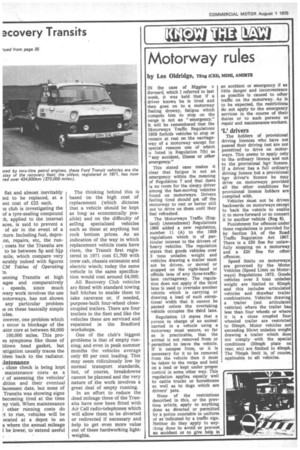Motorway rules
Page 38

If you've noticed an error in this article please click here to report it so we can fix it.
by Les Oldridge, TEng (CE.1), mall, AlvmvrE IN the case of Higgins v Bernard, which I referred to last week, it was held that if a driver knows he is tired and then goes on to a motorway feeling drowsy, fatigue which compels 'him to stop on the verge is not an "emergency." It will he remembered that the Motorways Traffic Regulations 1959 forbids vehicles to stop or remain at rest on the carriageway a a motorway except for special reasons one of which is listed in Regulation 7(b) as "any accident, illness or other emergency."
This stated case makes it clear that fatigue is not an emergency within the meaning of Regulation 7 and that there is no room for the sleepy driver among the fast-moving vehicles found on mdtorways. Drivers feeling tired should get off the motorway to rest or better still not to drive on them until they feel refreshed.
The Motorways Traffic (England) (Amendment) Regulations 1966 added a new regulation, number 11 (A) to the 1959 regulations which is of particular interest to the drivers of heavy vehicles. The regulation states that goods vehicles over 3 tons unladen weight and vehicles drawing a trailer must not be driven, or moved or stopped on the right-hand or offside lane of any three-trafficlane carriageway. The regulation does not apply if the third lane is used to overtake another vehicle which is carrying or drawing a load of such exceptional Width that it cannot be passed unless the overtaking vehicle occupies the third lane.
Regulation 13 states that a person in charge of an animal carried in a vehicle using a motorway must ensure, so far as is practicable, that the animal is not removed from or permitted to leave the vehicle. If it escapes from, or it is necessary for it To be removed from the vehicle then it must be taken to the verge and held on a lead or kept under proper control in some other way. This regulation applies equally well to cattle trucks or horseboxes as well as Co dogs which are drivers' pets.
None of the restrictions described in this, or the previous article, apply to anything done as directed or permitted by a police constable in uniform or as indicated by a traffic sign. Neither do they apply to any'thing done to avoid or prevent an accident or to give help In an accident or emergency if as little danger and inconvenience as possible is caused to other traffic on the motorway. As is to be expected, the restrictions do not apply to the emergency services in the course of their duties or to such persons as repair and maintenance workers.
'L' drivers
The holders of provisional driving licences who have not passed their driving test are not permitted to drive on motorways. This seems to apply only to the ordinary licence and not to the provisional hgv licence. If a driver has a full ordinary driving licence but a provisional hgv driver's licence he may drive on mcrtorways provided all the Other conditions for provisional licence holders are complied with.
Vehicles Must not be driven backwards on motorways except to back the vehicle to enable it to move forward or to connect it to another vehicle (Reg 8).
Punishment for offences under these regulations is provided for by Section 3A of the Road Traffic Regulation Act 1967. There is a £50 fine for unlawfully stopping on a motorway and a £20 fine for other offences.
Speed limits on motorways are governed by the Motor Vehicles (Speed Limit on Motorways) Regulations 1973. Goods vehidles over 3 tons unladen weight are limited to 60mph and this includes articulated vehicles and drawbar trailer combinations. Vehicles drawing a trailer (not articulated vehicles) Where the trailer has less than four wheels or where it is a close coupled four wheeled trailer are restricted to 50mph. Motor vehicles not exceeding 30cwt unladen weight drawing a trailer which does not comply with the special conditions (50mpli plate on rear, etc) are limited to 40mph. The 70mph limit is, of course, applicable to all vehicles.




















































































